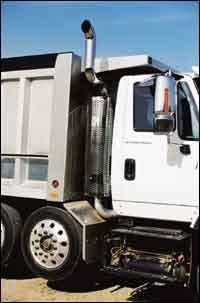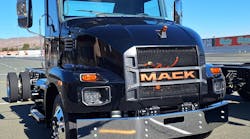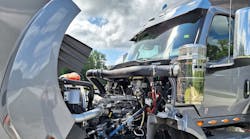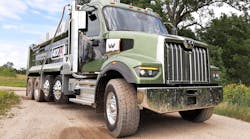Truck diesels now using exhaust-gas recirculation to lower emissions will continue to use EGR starting in 2007, manufacturers say, quashing speculation that another process might be used instead.
The good news for customers is that 2007 products will be similar to what's being built now, and should deliver about the same or slightly better fuel economy. The bad news is that most current models deliver poorer fuel economy than before, and buyers probably won't see much improvement. They may also see price increases similar to those imposed since the October 2002/January 2004 engines went into production.
Cummins, Detroit Diesel, International, Mack and Volvo all say that cooled EGR, plus exhaust particulate traps and other enhancements, will allow them to meet more stringent emissions rules that take effect in January 2007. EGR was first employed by them beginning in October 2002 to meet emissions regulations that went into effect at that time.
Imported diesels got the EGR equipment in January of this year. Among them are products from Mercedes-Benz, which are now marketed by Detroit Diesel. The DD/M-B organization, which is owned by DaimlerChrysler, was the latest to announce the decision to stick with EGR for 2007.
EGR equipment mixes small amounts of exhaust gas with inlet air to displace oxygen and cut combustion temperatures in the cylinders. This reduces the amount of nitrous oxides, or NOx, which causes smog formation. The process is called cooled EGR because the exhaust gas is cooled by engine jacketwater before being sent to the intake manifold through special piping and valving.
Caterpillar diesels will continue to avoid EGR by using other methods to meet the 2007 regulations. Beginning in October 2002, Cat sold "bridge" models that did not quite meet the limits, so Cat paid tens of millions of dollars in fines to the federal Environmental Protection Agency.
Cat now sells diesels with Advanced Combustion Emission-Reduction Technology that are fully compliant; these use particulate traps, and more thorough versions of the traps will be used in '07, the company said. Larger ACERT engines also use double turbo-charging, variable cam timing and other advancements.
Two engine models from Cummins also avoid EGR, but they will have it in '07, executives said. The engines are the medium/heavy-duty ISC and the heavy-duty ISL, which use EPA-issued "credits" that allow slightly higher emissions levels than for other '02/'04 diesels. EPA granted the credits because Cummins' ISB, a version of which is sold in high volumes in Dodge pickups, was cleaner than required prior to EPA's deadlines.
Without EGR, the ISC and ISL are less costly than competitors' comparable diesels and may be more fuel efficient as well. But Cummins does not advertise this because it would not speak well of the rest of its models, which must use EGR. The "enhanced" 2004 ISL has other advances and uses a variable-geometry turbocharger like EGR'd Cummins engines.
Clean diesel and trapsLike most other builders selling engines in Europe, Cummins, Detroit, Mercedes and Volvo will use Selective Catalytic Reduction (SCR) there, but not here. Going two different routes to meet emissions regs on the two continents complicates matters for builders, but will save users money, builders say.
With SCR, a chemical is injected into the exhaust to cleanse it of nitrous oxides and other hard-to-control pollutants. The chemical is an ammonia-based substance called urea. It effectively displaces varying amounts of diesel fuel, which in Europe is almost three times more expensive than in North America. Saving comparatively cheap diesel here with urea makes little sense because urea costs about the same. Moreover, it's feared that urea distribution might not be sufficient to get the chemical to users by 2007.
All '07 diesels will need ultra-low-sulfur diesel fuel, which must be produced and transported to wholesale distributors and retail pumps in time to meet the deadline. EPA has decreed that the new fuel be available by mid-summer of 2006; refiners reluctantly agreed to begin producing it, but the petroleum industry points out that it will be difficult to avoid contaminating the new fuel in existing pipelines, trucks and storage tanks without setting up a separate infrastructure. This will push up fuel prices, industry executives warn.
Diesel exhaust now is virtually smokeless and, with low levels of NOx, almost odorless. But 2007 regulations require NOx to be cut by another 52 percent and particulates by 90 percent. Traps will strip particulates from the exhaust stream and collect or burn them. Thus the traps will be more complex and costly than the catalytic converters used on Cat engines now, and they will require more maintenance.
"Packaging" the traps on construction trucks will be a challenge, but solutions already found for the Cat devices are likely to be the models for 2007 and beyond. The next step is 2010, when even stiffer limits must be met, but EPA has scheduled no further reductions after that.
Aside from having fairly familiar products, Cummins, Detroit, M-B, International, Mack and Volvo will also have 2007-spec engines available for customer testing well in advance of the deadline, manufacturers pointed out. Some will be sold as early as summer of 2005. Large fleet customers have complained bitterly that they didn't have enough time to test engines before the October 2002 deadline that most domestic builders had to meet.
EPA moved up its January 2004 emissions levels to October 2002 to punish domestic builders for allegedly violating emissions rules earlier in the '90s. Builders also paid millions in fines. Shortening the deadline caused builders to work hard and fast to modify their engines, but there was little time between finalizing designs and production, so few test engines got into customers' hands.
With little or no experience on which to base purchasing decisions, many freight-hauling fleets bought as many trucks with pre-October '02 diesels as they could. The massive "pre-buy" boosted production about 26 percent higher than it would have been under normal market conditions, said the General Accounting Office, an investigative arm of Congress, in a report released in March.
After October '02, orders fell off and fleets have resisted buying trucks until recently. This resulted in more comparatively dirty diesels going into service and fewer cleaner models than the EPA wanted, thus thwarting the agency's Clean Air goals, GAO said. It also caused a renewed slump in truck sales, which followed the recession-induced drop in sales that began in 2000.
Economy, durability and priceFuel economy is a big issue for over-the-road fleets whose biggest operating expense, after wages, is fuel. Fleets and individuals who run construction trucks worry less about fuel economy and more about durability. It's too soon to judge October '02/January '04 diesels on that score, though OTR fleets report mixed experiences with the new engines.
Some managers at OTR fleets report failures of EGR gear, and all say fuel economy is down from 1 to 15 percent. Fuel economy degradation varies by engine make and model, and by application. Engine makers suggest that their 2007 models will be no worse than now, and one or two suggest that fuel economy might improve slightly.
Purchase prices affect all truck buyers, and it's not yet known how much more the '07 trucks with the updated diesels will cost. A typical Class 8 truck with an October '02/ January '04 engine costs about $5,000 more than before. Engine makers haven't yet informed truck builders of the cost of '07 models, but observers are guessing that a similar price increase is in store. This could lead to another pre-buy, and some OTR fleet managers have said they plan exactly that.
Upcharges for diesel-powered medium- and light-duty trucks are less than for the heavies, and that should also be the case for '07. And unlike the controversies in the Class 8 market, buyers of lighter trucks have made virtually no complaints about the costlier new-tech diesels. That, manufacturers say, is because operators of lighter commercial trucks have other business matters to think about, while consumers who buy big diesel pickups need only worry about making their payments.
Click here for more information






